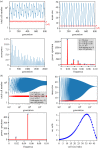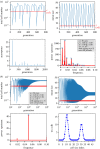Is the diatom sex clock a clock?
- PMID: 34129790
- PMCID: PMC8205531
- DOI: 10.1098/rsif.2021.0146
Is the diatom sex clock a clock?
Abstract
The unique life cycle of diatoms with continuous decreasing and restoration of the cell size leads to periodic fluctuations in cell size distribution and has been regarded as a multi-annual clock. To understand the long-term behaviour of a population analytically, generic mathematical models are investigated algebraically and numerically for their capability to describe periodic oscillations. Whereas the generally accepted simple concepts for the proliferation dynamics do not sustain oscillating behaviour owing to broadening of the size distribution, simulations show that a proposed limited lifetime of a newly synthesized cell wall slows down the relaxation towards a time-invariant equilibrium state to the order of a hundred thousand generations. In combination with seasonal perturbation events, the proliferation scheme with limited lifetime is able to explain long-lasting rhythms that are characteristic for diatom population dynamics. The life cycle thus resembles a pendulum clock that has to be wound up from time to time by seasonal perturbations rather than an oscillator represented by a limit cycle.
Keywords: clocks; diatoms; discrete models; matrix models; oscillations.
Figures










References
-
- Tréguer P, et al. 2018 Influence of diatom diversity on the ocean biological carbon pump. Nat. Geosci. 11, 27-37. (10.1038/s41561-017-0028-x) - DOI
-
- Nelson DM, Tréguer P, Brzezinski MA, Leynaert A, Quéguiner B. 1995. Production and dissolution of biogenic silica in the ocean: revised global estimates, comparison with regional data and relationship to biogenic sedimentation. Global Biogeochem. Cycles 9, 359-372. (10.1029/95GB01070) - DOI
-
- Smayda TJ. 1997. What is a bloom? A commentary. Limnol. Oceanogr. 42, 1132-1136. (10.4319/lo.1997.42.5_part_2.1132) - DOI
-
- Platt T, White GN, Thai L, Sathyendranath S, Roy S. 2009. The phenology of phytoplankton blooms: ecosystem indicators from remote sensing. Ecol. Model. 220, 3057-3069. (10.1016/j.ecolmodel.2008.11.022) - DOI
Publication types
MeSH terms
Associated data
LinkOut - more resources
Full Text Sources

